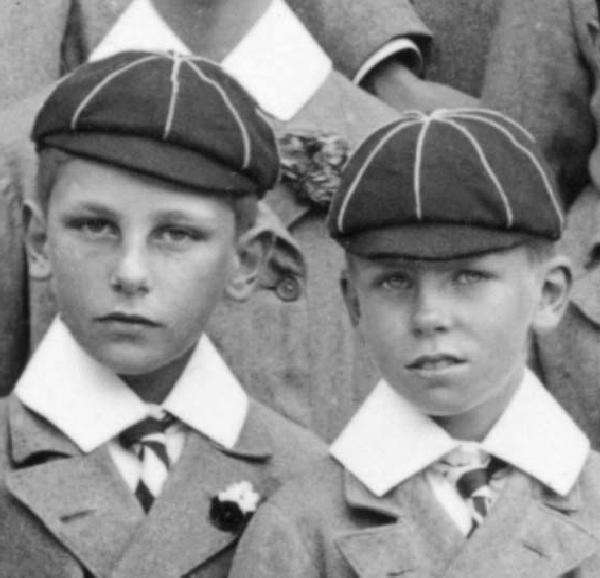
English School Uniform: Individual School -- Unknown Eastbourne Prep School Uniform Buttonaires

Figure 1.-- The boys at this school are all wearing identical Eton collrs. They are the classic Eton collar, which was a stiffly starched or celuloid material worn as a detachable collar to their shirt waists. All the Eton collars are the same size and perfetly starched. Botice the buttonaires that the boys are wearing. Image courtesy of the MD collection.
|
Notice that the headmaster wears a floral buttonaire. It has become a convention in England for children and teachers to wear a poppy buttonaire to school on November 11 in honor of the fallen soldiers of World War I. Modern children wear fake poppies, but poppies nine the less. Poppies were chosen because they were so common in Flanders where many British soldiers died and where poppies grow among the toumbstones of military cemetaries. This portrait, however was taken before World War I, so the buttonairs are more of a fashion statement. Interestingly, a few of the boys also weat buttonaires. This is intersting because the fact that only a few boys have them, means that it was not a convention supported by the school. We doubt if many boys this age were all that concerned about having flowers in their bitton holes. At these prep schools, the boys came from families that were for the most part of comforatable circumstamnces. Some of the boys were quite wealthy. We suspect that the boys wiyth the buttonaires are from wealthy families. They were probably accustomed tom all kinds of refinements. I assume that knowing about the school portrait that they sent out for flowers. Perhaps some of our British readers may no more of just how and where the buttonaires were suggested.
HBC

Related Chronolgy Pages in the Boys' Historical Web Site
[The 1880s]
[The 1890s]
[The 1900s]
[The 1910s]
[The 1920s]
[The 1930s]
[The 1940s]
[The 1950s]
Related Style Pages in the Boys' Historical Web Site
[Long pants suits]
[Short pants suits]
[Socks]
[Eton suits]
[Jacket and trousers]
[Blazer]
[School sandals]
Navigate the Boys' Historical Clothing School Uniform Pages
[Return to the Main Unknown Eastbourne prep school uniform page]
[Australia]
[England]
[France]
[Germany]
[Ireland]
[Italy]
[Japan]
[New Zealand]
[Scotland]
[United States]
Navigate the Boys' Historical Clothing Web Page
[Introduction]
[Activities]
[Biographies]
[Chronology]
[Clothing styles]
[Countries]
[Bibliographies]
[Contributions]
[FAQs]
[Glossaries]
[Satellites]
[Tools]
[Boys' Clothing Home]
Created: April 26, 2003
Last updated: April 26, 2003



